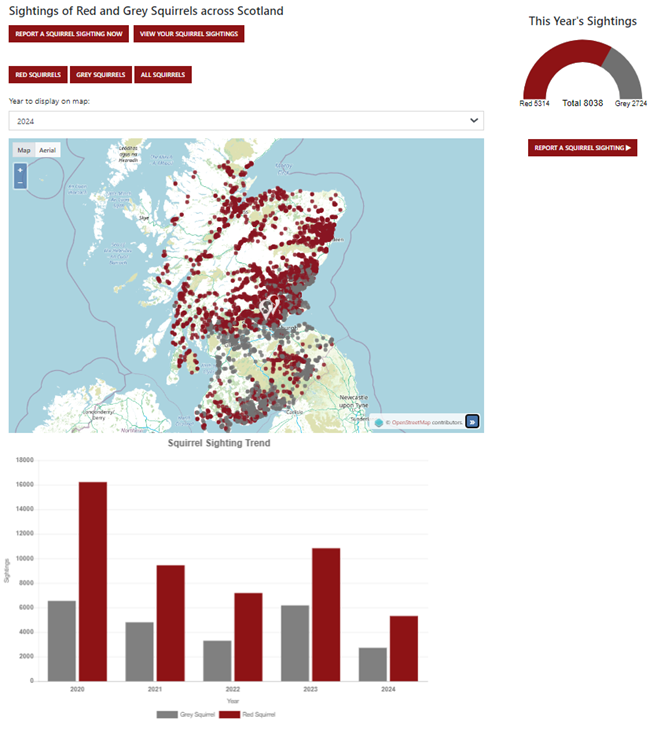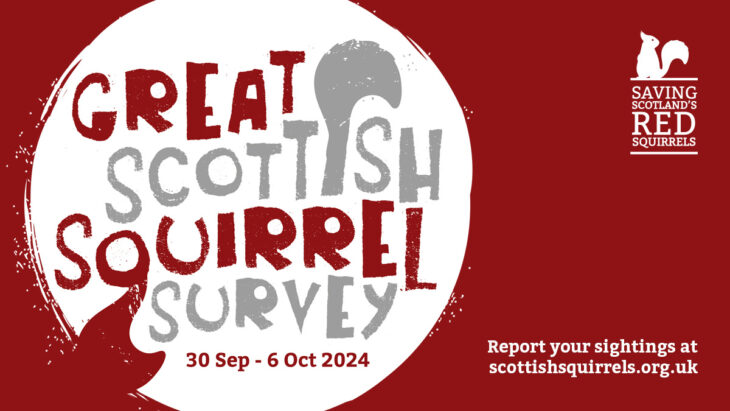About us
Using data to save one of Scotland’s ‘Big 5’
Using data to save the Red Squirrel – one of Scotland’s ‘Big 5’

Saving Scotland’s Red Squirrels (SSRS) is a partnership project working to ensure red squirrels continue to be a part of Scotland’s special native wildlife. While well over 75% of the UK’s remaining red squirrels are found here, their numbers have fallen drastically in recent decades. This is largely due to the spread of the invasive non-native grey squirrel, which was first introduced from North America in the late 1800s and outcompetes reds for food and living space. Some grey squirrels also carry squirrelpox, a virus that doesn’t harm them but is deadly to reds.
With the help of partners, landowners and local volunteers, the SSRS project is monitoring squirrel numbers across Scotland, managing the impact of squirrelpox, and helping to combat the spread of grey squirrels in key strategic areas.
The collection and analysis of squirrel data from across the country has long been recognised as a vital and essential resource in the fight to save red squirrels. As a result, since SSRS’s inception in 2009, a key focus for the project has been the obtaining and verifying of large amounts of data.
This data comes in a variety of types including:
- trapping and shooting records across conservation priority areas
- survey records detecting squirrel presence/ absence
- sightings of both red and grey squirrels from across the country
Data is submitted to SSRS from a diverse pool of sources including:
- landowners trapping with funding from the Forestry Grant Scheme (FGS)
- volunteer groups working to protect red squirrels in their immediate localities
- members of the public recording sightings of both species of squirrel
- staff collection of data from professional monitoring and trapping efforts

Such was the quantity of data being recorded and received, that in September 2018 SSRS launched its online Community Hub, an objective of which was to improve the quality and value of recorded information via the introduction of standardised web forms for the data collection. The ‘Hub’ is integrated with the SSRS website, and allows staff and volunteers to input their own sightings, control and survey data (as well as training records and volunteer hours) into consistent streamlined formats – creating a centralised space for access, analysis and sharing of data. Since the launch of the SSRS Hub, public, volunteer and stakeholder engagement with the project has greatly increased with website views in the year following the launch of the Hub increasing by 232%.

The Hub was supplemented in autumn 2019 with the launch of the ever-popular Great Scottish Squirrel Survey (GSSS), now in its 6th year, a public campaign which encourages people to submit as many squirrel sightings as possible in one week to provide a snapshot of squirrel population distributions across the country. In 2020, its most successful year, over 2100 people reported over 3000 squirrel sightings in a single week.
The success of both the Hub and GSSS has resulted in a significant rise in data collection, with over 84,000 public squirrel sightings (over 11,000 of which have come from GSSS) and almost 50,000 grey squirrel control records verified since 2018. The impact of this high quantity and quality of data collection upon red squirrel conservation in Scotland is significant. Having all SSRS data pooled into one database allows the SSRS data team to extract accurate figures for reporting; pull data to create maps and tools for staff working operationally on the ground; generate datasets to share with scientists and researchers; and prepare an annual dataset of squirrel records to upload to the NBN Atlas Scotland. The total NBN Atlas squirrel records for Scotland as of December 2023 was an incredible 204,861 (this total figure includes externally submitted records).
This sheer number of verified records for two single species in Scotland is almost unique in scale, and has a significant impact on conservation operations on the ground. These records inform where best to focus trapping and monitoring efforts within priority areas, help detect grey squirrels in critical incursion routes, allow for evaluation of other work on the landscape such as the government’s Forestry Grants Scheme, and help to direct and inform local and national red squirrel operational plans and strategies led by various NGOs, volunteer organisations, and government bodies.
SSRS is currently supported by the Scottish Government’s Nature Restoration Fund, managed by NatureScot, along with project partners. For more information on their work and to take part in the upcoming 2024 Great Scottish Squirrel Survey (30 Sep – 6 Oct) please visit scottishsquirrels.org.uk.

This biodiversity data story was shared by Saving Scotland’s Red Squirrels with the Better Biodiversity Data project, led and managed by the NBN Trust and supported by NatureScot and The Scottish Government.

